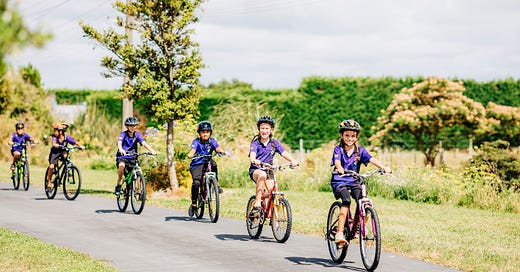A new international report shows New Zealand among the lowest for active transport to school.
That was the headline from Newshub in response to the release of the Global Matrix 4.0 Physical Activity Report Card Grades for Children and Adolescents. The study collected data from 57 countries and graded them on a range of measures, including active transport to school. Active transport was defined by the study as any form of human-powered transportation - walking, cycling, using a wheelchair, in-line skating, or skateboarding. Countries were graded based on the percentage of children and adolescents who use active transport to get to and from places.
Worryingly for our tamariki, Aotearoa scored a D grade for active transport - with only five countries performing worse. Our dismal rating is a reflection of a nationwide problem. The 2018 census showed only 24.1% of people use active transport as their main means of travel to education. That figure drops even more sharply to 7.2% for travel to work.
We’re doing slightly better in Kirikiriroa, with 27.7% of people using active transport as their means of travel to education. A demographic breakdown shows that figure is 30.6% for students aged 10-14 and 32.9% for students aged 15-29.
So those are the numbers, but what’s all the fuss about? To put it simply, physical inactivity is not good for our tamariki (or anyone for that matter).
Here’s what the World Health Organisation has to say:
In children and adolescents, higher amounts of sedentary behaviour are associated with the following poor health outcomes: … poorer cardiometabolic health, fitness, behavioural conduct/pro-social behaviour; and reduced sleep duration.
I don’t know about you but I’d prefer if our tamariki were getting a good night's sleep, spending more time with friends, achieving better academic performance at school, and generally being in good physical and mental health.
The low use of active transport by our tamaraki is particularly relevant for us here in Kirikiriroa. We’re the youngest of Aotearoa’s 67 territorial authorities with half of our population under the age of 32. Our youthfulness is recognised in the refresh of Access Hamilton, the transport strategy for our city, as the way we move contributes to people’s ability to enjoy life and feel part of a community.
The strategy refresh paints a picture of a city where physical activity is built into the way we move. Every school has walking buses and bike trains as our streets are comfortable and safe places for young people. Our tamariki walk down to play at Hamilton Gardens, ride their bikes along Te Awa to visit the Waikato Museum, grab their skateboards and head down to Melville Skate Park, or spontaneously play with neighbours in the street
We can make that future where movement is about physical fun and adventure a reality too. As Access Hamilton says, we need infrastructure improvements to deliver safe walkways and cycleways, implement safe speed environments and connect our green spaces to our streets. We need schools to have high-quality end-of-trip facilities such as bike and scooter parking. We need school travel planning and community programmes to educate and encourage more of our tamariki to walk and bike.
We need to make bold and necessary changes in Kirikiriroa. To move away from a backseat generation, where the focus on roads designed for cars has made physical activity a special occurrence. Instead, we need to move towards a modern city designed around people that makes physical activity an invisible part of our daily lives.

We all benefit from this future. People who need to drive don’t have to battle with as many cars on the road. The long-term sustainability of business is protected as mode shift supports our city becoming more densely populated. Our streets become peaceful, safer and less polluted. The communities we belong to become more socially connected, and our individual physical and mental well-being improves as physical activity becomes a normal part of how we move around the city.
As award-winning author and urbanist, Charles Montgomery, has said:
“Our culture obsesses about the care of children. We declare their well-being the most important thing in the world. Yet we keep building places that steal their freedom and put them in danger. I often wonder, ‘What kind of place would we create if we really wanted to meet our stated ambition of caring for our children?’.”
It’s time for us to stop wondering. It’s time for us to create that world. For our tamariki.
Matt Leach is a transport advocate and co-chair of Bike Waikato.




